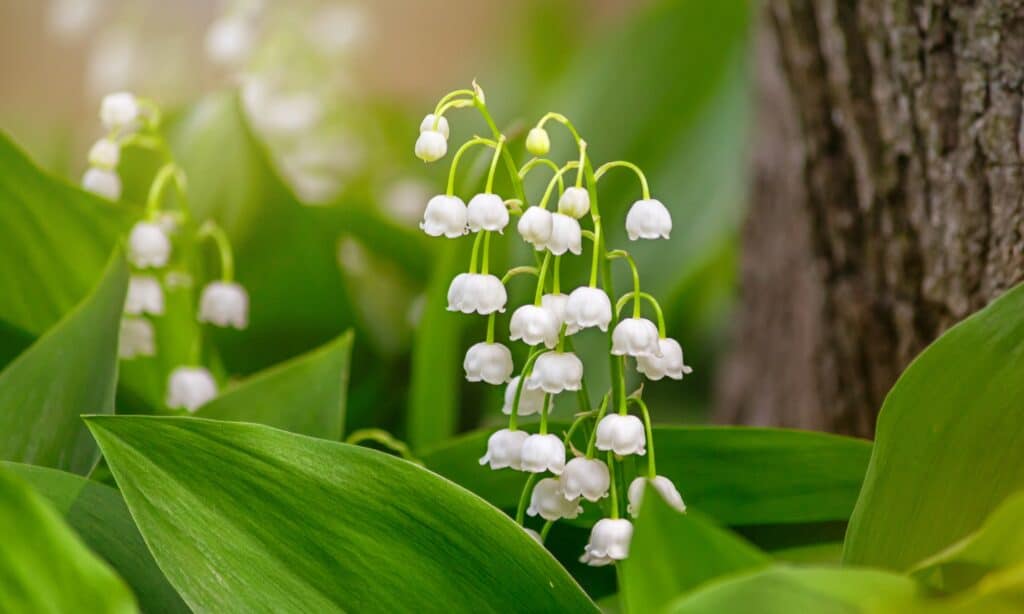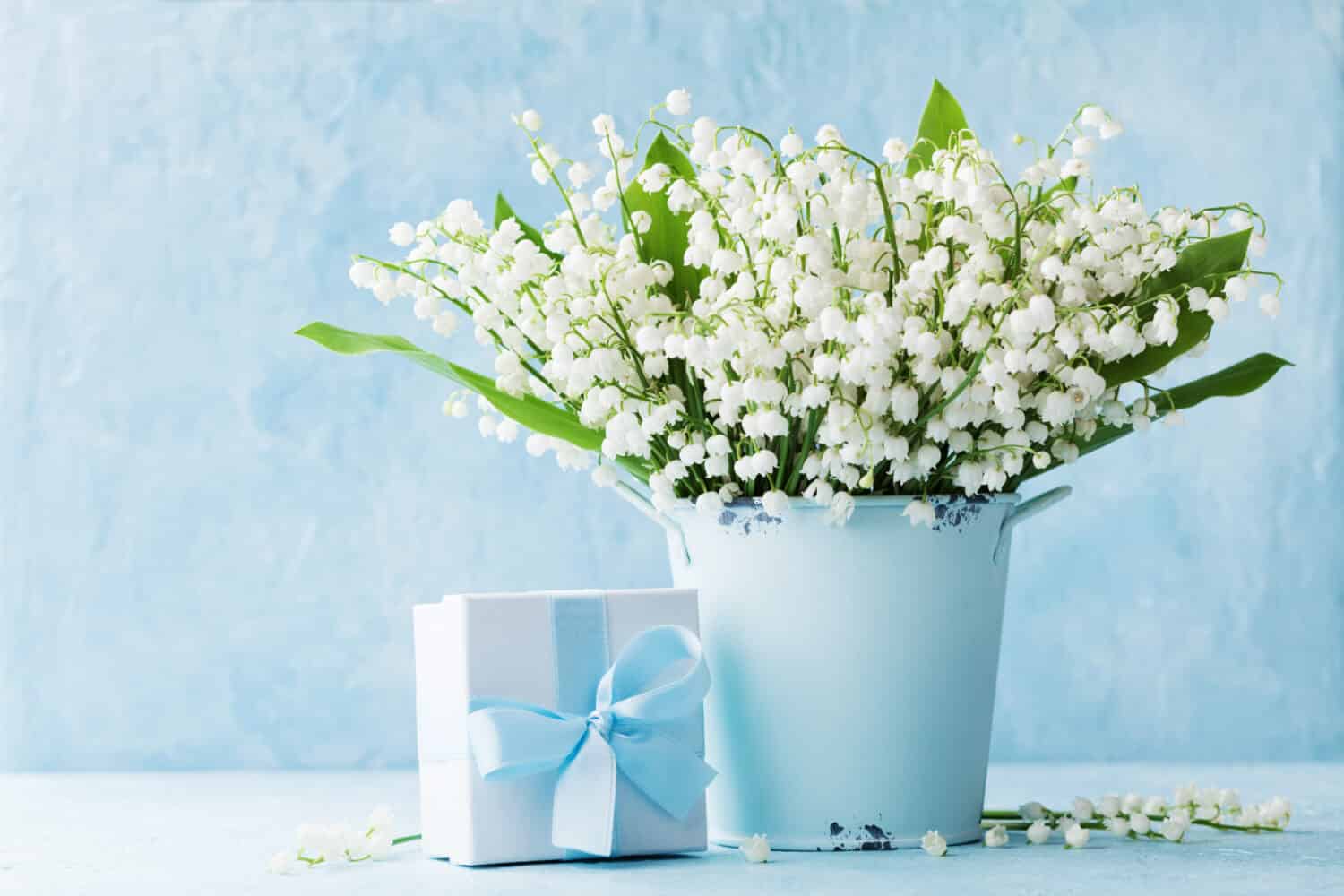Delicate and sweet, the lily of the valley seems to combine enchantment and beauty in its tiny white blossoms and long elegant leaves. Its sweet fragrance belies its small size, evoking visions of springtime and wonder. Important symbols in art, religion, birthdays, and springtime, lilies of the valley have long been revered for both their beauty and meaning. In this article, we’ll take a closer look at the meaning and symbolism of the lily of the valley, a graceful little flower that radiates both melancholy and heartbreak, as well as hope and new beginnings!
What Is Lily of the Valley?
Despite its name, the lily of the valley (Convallaria majalis) isn’t a lily at all — it actually belongs to the asparagus family! This beautiful woodland flowering plant is native to Europe and Asia. It blooms in the spring, with tiny blossoms that hang in pendant-like clusters. The flowers are small and delicate, like little white bells dancing together in the wind. Both beautiful and aromatic, lilies of the valley fill the air around them with a seat sweet scent that many use in perfumes.
After the flowers have gone, the lily of the valley produces inedible, poisonous orange or red berries in the fall. It is important to note that these plants contain a large concentration of cardiac glycosides. So, all parts of the lily of the valley are poisonous to both humans and animals.
The lily of the valley grows low to the ground. It grows just 6 to 12 inches tall and spreads out through its rhizomes (underground stems). Many people use this plant as a beautiful ground cover but be warned that it could take over as it is aggressive when it spreads. Liles of the valley work great in planters, pots, and floral arrangements as well.
If you would like to plant a lily of the valley, you should do so in the spring or fall. Make sure that you choose a spot with well-draining soil with shade or partial shade as well. Lilies of the valley are perennial plants, so they come back each year in the spring. However, you should divide the plants every three to four years to prevent them from spreading and taking over your garden.

While the lily of the valley plant looks beautiful in bloom, it produces poisonous berries.
©Klymenko Mariia/Shutterstock.com
Lily of the Valley Meaning and Symbolism
The lily of the valley is a popular plant due to its delicate blossoms and sweet-smelling fragrance. It has many different names, such as glovewort (it was once used to make a salve for sore hands), and Apollinaris, due to its association with the ancient Greek god Apollo. Let’s take a closer look at the various names, meanings, and symbolism of the lily of the valley!
Purity and Innocence
According to ancient Greek mythology, the mighty god Apollo originally created the lily of the valley as a gift for the nine nymphs or muses under his care. Apollo wanted the nymphs to have a soft and fragrant path on Montparnasse where they could feel safe and content. However, this naturally growing carpet needed to live up to the legendary grace and beauty of the nymphs. So, Apollo designed and created the lily of the valley. The tiny white flowers were as delicate and pure as the nymphs themselves.
The flowers came to symbolize the nymphs’ innocence and purity. They also became a symbol of protection, as the flowering path protected the nymphs’ delicate feet from the forest floor.

Lilies of the valley grow well as groundcover and along garden edges.
©Agnes Kantaruk/Shutterstock.com
Protection
In addition to the protection Apollo’s lily of the valley flowers provided to the nymphs, many tales in folklore associate these flowers with woodland fairies. The fairies are said to drink from the flower’s tiny cup-shaped blossoms. If you plant lilies of the valley in your garden for these magical visitors, they will help to protect your home from evil spirits.
Virgin Mary, Tears, and Mourning
The lily of the valley also has great symbolic meaning in the Christian tradition. According to legend, the Virgin Mary watched as her beloved son, Jesus, was crucified by the Romans. As she cried in sorrow, her many tears fell to the ground, transforming into tiny white flowers. These lilies of the valley came to symbolize Mary’s pain, tears, and mourning for her son, as well as her pure and loving heart. Today, the lily of the valley is also called “Our Lady’s Tears” and “Mary’s Tears”. The flowers are common at funerals and express condolence and sympathy.
According to another Christian story, the lily of the valley sprouted from Eve’s tears after she was forced out of the Garden of Eden. For both Mary and Eve, the tiny blossoms symbolized their heartbreak and the tears they shed.

The sweet, small blossoms of the lily of the valley make it popular for bouquets.
©Cholpan/Shutterstock.com
Hope and New Beginnings
Although the lily of the valley is said to have grown from the tears of Eve and Mary, it is also a symbol of hope and new beginnings. In the case of Eve, her tears were transformed into something beautiful after leaving the garden, symbolizing the new life she was beginning. For Mary, the flower symbolizes both her sorrow and her joy when Jesus returned from the dead.
The Germanic goddess Ostara, the goddess of spring and new beginnings, is often depicted with a lily of the valley as her symbol. Lilies of the valley are common gifts on Ostara (the Spring Equinox) and in many decorations and rituals. They are also used to celebrate Beltane, the Gaelic May Day.
Spring and Rebirth
The lily of the valley is also called the “May Lily”. It is common in both religious and secular celebrations of spring, particularly on May first, or May Day. In fact, the scientific name for the lily of the valley, Convallaria majalis, comes from two Latin words: “convallis,” which means valley, and “majalis,” which means belonging to May. The lily of the valley is the official birth flower for the month of May as well.
Many people in France decorate their homes with the delicate lily of the valley to celebrate May Day or La Fête du Muguet (Lily of the Valley Day). They call the flowers May lilies or May bells because they welcome the arrival of spring with their sweet presence.
In Great Britain, particularly in Cornwall, the lily of the valley serves as the symbolic flower for the town of Helston. Each year on May eighth, the people celebrate the arrival of spring with the Furry Dance. Dancers wearing lilies of the valley as a symbol of the new season.
In Serbia, the lily of the valley is called Djurdjevak, or St. George’s plant. People pick lilies of the valley for Djurdjevdan, or St. George’s Day, and use them for decorations. Celebrated on May sixth, Djurdjevdan honors the arrival of spring and the rebirth of the natural world.

The lily of the valley has many different names, including Mary’s tears, May bells, muguet, and glovewort.
©iStock.com/rustamank
Good Luck and Love
Alongside hope and new beginnings, the lily of the valley is also a symbol of good luck. Stories say that King Charles IX received a sprig from a lily of the valley. He liked it so much, that he gave bouquets of these tiny flowers to the ladies of his court to wish them luck and happiness each year on the first of May. In France, May Day is called La Fête du Muguet, or “Lily of the Valley Day”.
Another ancient tale recounts the whimsical love story between a delicate lily of the valley and a nightingale. The nightingale visited the flower garden each night to share his song, and the lily of the valley fell in love with it. However, the plant was shy and hid herself away. Over time, the nightingale grew weary of singing without having someone respond to his song, so he flew away. The flower waited and waited for the bird to return, but the loneliness sunk deep into her soul, and she stopped blooming. However, in May the nightingale finally returned, and the lily of the valley’s blooms burst open with her happiness.
Accordingly, couples and newlyweds often plant lilies of the valley in their gardens to bring them good luck and love. Many royal brides also choose to include these beautiful blossoms in their weddings. Queen Victoria, Grace Kelly, Princess Astrid of Sweden, Princess Tatiana of Greece, Queen Máxima of the Netherlands, and Kate Middleton all had lilies of the valley in their bridal bouquets.
A Return to Happiness
According to the Victorian language of flowers, the lily of the valley symbolizes a return of happiness. Legends tell of St. Leonard who slayed the last dragon of England. Following the epic battle, lilies of the valley began to blossom wherever his blood had spilled, marking the saint’s return to happiness and peace. In addition, you can also combine lilies of the valley with Protea to symbolize changing a bad situation into something good, or with yarrow to soothe a broken heart.

Lilies of the valley make great gifts for friends and loved ones, as they symbolize happiness and hope.
©Julia Sudnitskaya/Shutterstock.com
Proper Occasions for Lily of the Valley
May Birthdays
The lily of the valley is a symbol of spring and blooms during the month of May. This makes it the perfect birth flower for anyone born during the month of May. Its sweet fragrance is also associated with springtime, symbolizing new beginnings and well wishes on someone’s special day.
Many of those with a May birthday are also born under the astrological sign of Gemini. As the lily of the valley is a symbol of hope, rejuvenation, and new beginnings, it coincides well with the free-spirited, versatile, and gentle nature of this zodiac sign.
Funerals, Condolences, and Sympathy
The delicate beauty of the lily of the valley captivates with its elegant, hanging blossoms. These exquisite blooms have long been associated with tears — such as those of the Virgin Mary and Eve — and they are a poignant symbol of sorrow. Lilies of the valley are often included in sympathy and funerary bouquets, offering solace and comfort in times of loss and heartbreak. Their graceful presence also adds a touch of sweetness intertwined with empathy and remembrance.
Weddings
The legendary tale of the lily of the valley and the nightingale is a symbol of love. This makes the delicate blossoms of the lily of the valley a time-honored choice for wedding bouquets and floral arrangements. In addition, their sweet-smelling fragrance creates an enchanting atmosphere, and their tiny white blossoms provide a simple elegance to any wedding celebration.
Spring Decorations and Celebrations
The lily of the valley is a perennial flower that returns year after year, blooming in May as it announces springtime. Standing as a symbol of rebirth, spring, and new beginnings, it is the perfect addition to springtime decorations and celebrations. Whether adorning a table centerpiece or accentuating a bridal bouquet, the delicate charm of the flower’s dainty bell-shaped blooms creates a simple but elegant ambiance. In addition, the flower’s distinct fragrance embodies the essence of spring and brings joy to the celebrations.

Every part of these beautiful plants is poisonous to both humans and animals! Be careful when using.
©Natali9701/Shutterstock.com
The photo featured at the top of this post is © iStock.com/rustamank
Thank you for reading! Have some feedback for us? Contact the AZ Animals editorial team.






